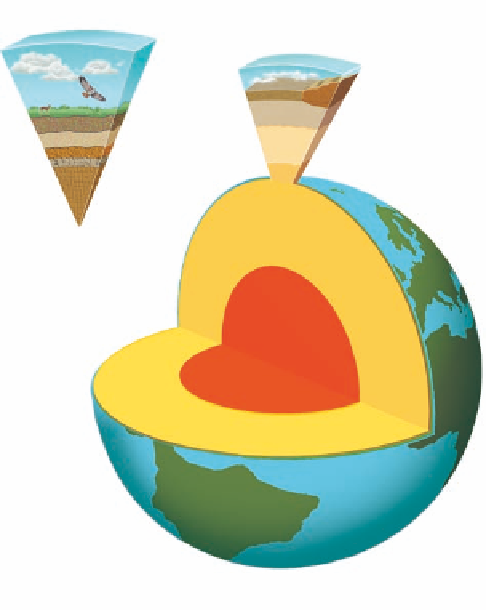Environmental Engineering Reference
In-Depth Information
We can think of the earth as consisting of
several spherical layers (Figure 3-5). The
atmo-
sphere
is a thin envelope or membrane of air
around the planet. Its inner layer, the
tropo-
sphere,
extends only about 17 kilometers
(11 miles) above sea level. It contains the ma-
jority of the planet's air, mostly nitrogen (78%)
and oxygen (21%).
The next layer, stretching 17-48 kilome-
ters (11-30 miles) above the earth's surface, is
the
stratosphere.
Its lower portion contains
enough ozone (O
3
)tofilter out most of the
sun's harmful ultraviolet radiation. This al-
lows life to exist on land and in the surface
layers of bodies of water.
The
hydrosphere
consists of the earth's
water. It is found as
liquid water
(on the planet's
surface and underground),
ice
(polar ice, ice-
bergs, and ice in frozen soil layers called
permafrost
), and
water vapor
in the atmosphere.
The earth consists of an intensely hot
core,
a
mantle
consisting mostly of rock, and a thin
crust.
The
lithosphere
is the earth's crust and
upper mantle.
Figure 3-4
Natural capital:
the
genetic diversity
among individuals of one
species of Caribbean snail is reflected in the variations in shell color and
banding patterns.
variation is called a population's
genetic diversity
(Figure 3-4).
The place where a population (or an indi-
vidual organism) normally lives is its
habitat.
It
may be as large as an ocean or as small as the in-
testine of a termite.
A
community,
or
biological community,
consists of all the populations of different spe-
cies of plants, animals, and microorganisms
living and interacting in an area.
An
ecosystem
is a community of different
species interacting with one another and with
their physical environment of matter and energy.
Ecosystems can range in size from a puddle of
water to a stream, a patch of woods, an entire forest, or a
desert. Ecosystems can be natural or artificial (human
created). Examples of artificial ecosystems include crop
fields, farm ponds, and reservoirs. All of the earth's
ecosystems together make up the
biosphere.
Oceanic
crust
Continental
crust
Atmosphere
Vegetation
and animals
Soil
Rock
Biosphere
Lithosphere
Upper mantle
Crust
Asthenosphere
Lower mantle
Core
Mantle
Learn more about how earth's life is organized on five levels
in the study of ecology at Environmental ScienceNow.
Crust
(soil
and rock)
3-2 THE EARTH'S LIFE-SUPPORT
SYSTEMS
Biosphere
(living and dead
organisms)
Hydrosphere
(water)
The Earth's Life-Support Systems:
Four Spheres
The earth is made up of interconnected spherical
layers that contain air, water, soil, minerals, and life.
Atmosphere
(air)
Lithosphere
(crust, top of upper mantle)
Figure 3-5
Natural capital:
general structure of the earth.








